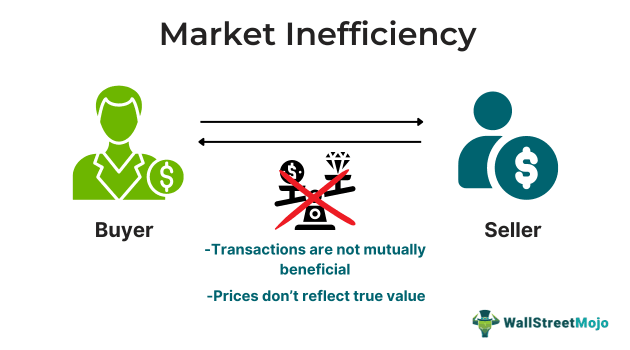Table of Contents
What Is Market Inefficiency?
Market inefficiency is a condition where the dealings or transactions between parties in a market don’t reflect fairness or are not mutually beneficial for both. Thus, such a market fails to provide the benefits equivalent to the cost or couldn’t perform at its best.

Inefficiencies arise due to imperfectly competitive markets where the key drivers are monopoly, free riding, asymmetric information, and negative and positive externalities. A common issue in a market prone to inefficiencies is the deadweight loss, where the marginal costs exceed the marginal benefits, causing one party to benefit more than the other.
Key Takeaways
- Market inefficiency is a market scenario where the parties to a transaction don’t derive equal benefits, causing one party a higher marginal cost compared to the benefits they achieve. It, therefore, results in an inadequate market outcome.
- The factors causing inefficiencies include monopoly, asymmetric information, free riding, and positive and negative externalities.
- There are three kinds of inefficiencies: productive, allocative, and information inefficiency.
- The best way to detect market inefficiency is by finding the difference between the actual and the ideal market outcomes.
Market Inefficiency Explained
Market inefficiency refers to the state of the market when the transactions are not equally beneficial for both buyers and sellers, leading to suboptimal outcomes. When one party gains more than the other, the optimal market outcome is compromised, leading to higher costs or lower benefits for the disadvantaged party. This imbalance can result in market failure, where the market doesn't meet the criteria of mutual satisfaction. In such a market, either sellers or buyers may have the power to influence prices or output quantities.
Complete market perfection is not possible in real life since the markets are often functional upon the dynamics of demand and supply, which can never be at equilibrium. Thus, some of the significant types of market inefficiencies are discussed below:
- Allocative: In the allocative market failure, the marginal cost of a good or service is different from its price.
- Informational Inefficiency: In such a situation, one party deliberately hides information from the other party in the transaction, resulting in less benefit to the latter.
- Productive: The producers intentionally create a productive inefficiency by producing less or more than the optimal output.
All these imperfect market scenarios result in total surplus deadweight loss where either the producers or the consumers would experience the loss of benefits.
Factors
While fair market competition is essential for a balanced economy, market inefficiencies often depress the confidence of the market participants. Given below are the various causes of such an imperfection:
- Monopoly: In such a market, only one seller or producer reins the market since the buyers have no other substitute for their product or service. Thus, such a monopolist produces in low quantities, and consumers buy at a lower level than optimal.
- Free Riding: Public goods are often produced with little incentive but are used by everybody. Thus, the users have a free riding benefit from these public resources, which creates an imperfect market.
- Information Asymmetry: The market where one party holds more information than the other party with an intention to have higher benefit than the latter causes an information asymmetry.
- Positive and Negative Externalities: Externalities and market efficiency are closely knitted. The third-party impact occurs from the production or consumption of a particular product. Such an effect is said to be positive if it has a favorable effect on the third party. However, a negative externality means an unfavorable influence over the third party.
How To Identify?
When market inefficiency occurs, the optimal outcome is compromised. Policymakers and governments need to gauge these inefficiencies. The best way to identify market inefficiencies is by comparing the actual market outcome with the ideal outcome under Pareto efficiency or perfect competition. Furthermore, tools and methods used to gauge the extent of deviation from ideal results include empirical evidence, graphical analysis, experimental methods, and mathematical models.
Examples
Market inefficiency or failure often results from various anomalies, which can lead to imperfect competition, as shown in the following examples:
Example #1 - Externalities and Market Inefficiency
Suppose a steel manufacturing company uses coal as fuel to operate its machinery at the factory premises. Now, the smoke from the factory is released into the atmosphere through the chimneys. In this case, market inefficiency arises from the negative externality that occurs when such production causes a demerit to the general public or society in the form of polluted air. Although the sufferers may not be the producers or consumers, the producer sacrifices public health for their economic profit.
Example #2
The onion shortage during December 2023 was due to a supply-demand imbalance worsened by market inefficiency. Even though its production slightly exceeded its demand, significant losses resulted from the deficit due to onion mishandling, rotting, and hoarding. Meanwhile, the government took measures like importing and restricting hoarding to stabilize the onion supply and price.
However, these interventions may cause long-term negative repercussions if not managed properly. Further, the significant challenges in handling this imperfect market situation were poor government planning, hoarding by non-market players, and limited support for domestic production. These market failures emphasized the need for effective government regulation for the efficient functioning of the markets and to avoid artificial onion shortages and price hikes.
